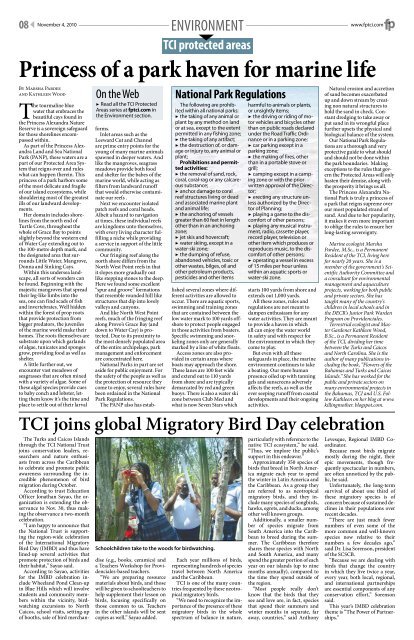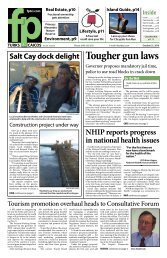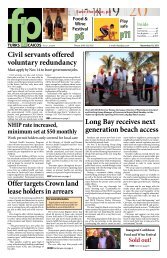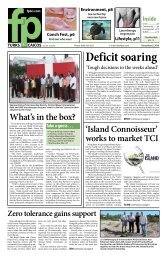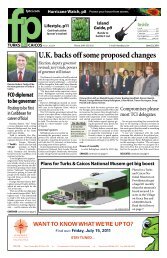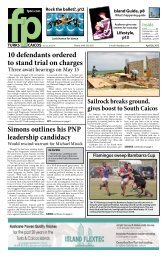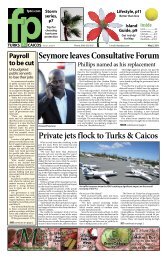TCI Bank must liquidate - fp Turks and Caicos
TCI Bank must liquidate - fp Turks and Caicos
TCI Bank must liquidate - fp Turks and Caicos
You also want an ePaper? Increase the reach of your titles
YUMPU automatically turns print PDFs into web optimized ePapers that Google loves.
▶<br />
08 ENVIRONMENT<br />
<br />
<strong>TCI</strong> protected areas<br />
November 4, 2010 _________________________________________________________________________________________________________ www.<strong>fp</strong>tci.com<br />
Princess of a park haven for marine life<br />
By Marsha Pardee<br />
<strong>and</strong> Kathleen Wood<br />
The tourmaline blue<br />
water that embraces the<br />
beautiful cays found in<br />
the Princess Alex<strong>and</strong>ra Nature<br />
Reserve is a sovereign safeguard<br />
for those shorelines encompassed<br />
within.<br />
As part of the Princess Alex<strong>and</strong>ra<br />
L<strong>and</strong> <strong>and</strong> Sea National<br />
Park (PANP), these waters are a<br />
part of our Protected Area System<br />
that reigns over <strong>and</strong> rules<br />
what can happen therein. This<br />
princess of a park harbors some<br />
of the most delicate <strong>and</strong> fragile<br />
of our isl<strong>and</strong> ecosystems, while<br />
shouldering most of the greatest<br />
ills of our l<strong>and</strong>ward developments.<br />
Her domain includes shorelines<br />
from the north end of<br />
Turtle Cove, throughout the<br />
whole of Grace Bay to points<br />
slightly beyond the western end<br />
of Water Cay extending out to<br />
the 100-metre depth mark, <strong>and</strong><br />
the designated area that surrounds<br />
Little Water, Mangrove,<br />
Donna <strong>and</strong> Sinking Cays.<br />
Within this undersea l<strong>and</strong>scape,<br />
all sorts of wonders can<br />
be found. Beginning with the<br />
majestic mangroves that spread<br />
their leg-like limbs into the<br />
sea, one can find scads of fish<br />
<strong>and</strong> invertebrates. Well hidden<br />
within the forest of prop roots<br />
that provide protection from<br />
bigger predators, the juveniles<br />
of the marine world make their<br />
homes. The roots themselves are<br />
substrate upon which garl<strong>and</strong>s<br />
of algae, tunicates <strong>and</strong> sponges<br />
grow, providing food as well as<br />
shelter.<br />
A little further out, we<br />
encounter vast meadows of<br />
seagrasses that are often mixed<br />
with a variety of algae. Some of<br />
these algal species provide cues<br />
to baby conch <strong>and</strong> lobster, letting<br />
them know it’s the time <strong>and</strong><br />
place to settle out of their larval<br />
On the Web<br />
▶▶Read all the <strong>TCI</strong> Protected<br />
Areas series at <strong>fp</strong>tci.com in<br />
the Environment section.<br />
The <strong>Turks</strong> <strong>and</strong> <strong>Caicos</strong> Isl<strong>and</strong>s<br />
through the <strong>TCI</strong> National Trust<br />
joins conservation leaders, researchers<br />
<strong>and</strong> nature enthusiasts<br />
from across the Caribbean<br />
to celebrate <strong>and</strong> promote public<br />
awareness surrounding the incredible<br />
phenomenon of bird<br />
migration during October.<br />
According to trust Education<br />
Officer Jonathan Sayao, the organization<br />
is extending the observance<br />
to Nov. 30, thus making<br />
the observance a two-month<br />
celebration.<br />
“I am happy to announce that<br />
the National Trust is supporting<br />
the region-wide celebration<br />
of the International Migratory<br />
Bird Day (IMBD) <strong>and</strong> thus have<br />
lined-up several activities that<br />
promote protection of birds <strong>and</strong><br />
their habitat,” Sayao said.<br />
According to Sayao, activities<br />
for the IMBD celebration include<br />
Wheel<strong>and</strong> Pond Clean-up<br />
in Blue Hills which will involve<br />
students <strong>and</strong> community members<br />
within the vicinity, birdwatching<br />
excursions to North<br />
<strong>Caicos</strong>, school visits, setting-up<br />
of booths, sale of bird merch<strong>and</strong>ise<br />
(e.g., books, ceramics) <strong>and</strong><br />
a Teachers Workshop for Providenciales-based<br />
teachers.<br />
“We are preparing resource<br />
materials about birds, <strong>and</strong> those<br />
will be given to schoolteachers to<br />
help supplement their lesson on<br />
birds, focusing specifically on<br />
those common to us. Teachers<br />
in the other isl<strong>and</strong>s will be sent<br />
copies as well,” Sayao added.<br />
forms.<br />
Inlet areas such as the<br />
Leeward Cut <strong>and</strong> Channel<br />
are prime entry points for the<br />
young of many marine animals<br />
spawned in deeper waters. And<br />
like the mangroves, seagrass<br />
meadows provide both food<br />
<strong>and</strong> shelter for the babes of the<br />
marine world, while acting as<br />
filters from l<strong>and</strong>ward runoff<br />
that would otherwise contaminate<br />
our reefs .<br />
Next we encounter isolated<br />
patch reefs <strong>and</strong> coral heads.<br />
Albeit a hazard to navigation<br />
at times, these individual reefs<br />
are kingdoms unto themselves,<br />
with every living character fulfilling<br />
a niche while providing<br />
a service in support of the little<br />
community.<br />
Our fringing reef along the<br />
north shore differs from the<br />
North West Point reefs in that<br />
it slopes more gradually out<br />
like stepping stones to the deep.<br />
Here we found some excellent<br />
“spur <strong>and</strong> groove” formations<br />
that resemble rounded hill like<br />
structures that dip into lovely<br />
valleys <strong>and</strong> canyons.<br />
And like North West Point<br />
reefs, much of the fringing reef<br />
along Provo’s Grace Bay (<strong>and</strong><br />
down to Water Cay) is protected.<br />
Due to its proximity to<br />
the most densely populated area<br />
of the entire archipelago, park<br />
management <strong>and</strong> enforcement<br />
are concentrated here.<br />
National Parks in part are set<br />
aside for public enjoyment. For<br />
the safety of the people as well as<br />
the protection of resource they<br />
come to enjoy, several rules have<br />
been ordained in the National<br />
Park Regulations.<br />
The PANP also has established<br />
several zones where different<br />
activities are allowed to<br />
occur. There are aquatic sports,<br />
swimming <strong>and</strong> training zones<br />
that are contained between the<br />
low water mark to 100 yards offshore<br />
to protect people engaged<br />
in those activities from boaters.<br />
Specific swimming <strong>and</strong> snorkeling<br />
zones only are generally<br />
marked by a line of white floats.<br />
Access zones are also provided<br />
in certain areas where<br />
boats may approach the shore.<br />
These lanes are 100 feet wide<br />
<strong>and</strong> extend out to 110 yards<br />
from shore <strong>and</strong> are typically<br />
demarcated by red <strong>and</strong> green<br />
buoys. There is also a water ski<br />
zone between Club Med <strong>and</strong><br />
what is now Seven Stars which<br />
Each year millions of birds,<br />
representing hundreds of species<br />
travel between North America<br />
<strong>and</strong> the Caribbean.<br />
<strong>TCI</strong> is one of the many countries<br />
frequented by these neotropical<br />
migratory birds.<br />
“We need to recognize the importance<br />
of the presence of these<br />
migratory birds in the whole<br />
spectrum of balance in nature,<br />
starts 100 yards from shore <strong>and</strong><br />
extends out 1,000 yards.<br />
All these zones, rules <strong>and</strong><br />
regulations are not meant to<br />
dampen enthusiasm for any<br />
water activities. They are meant<br />
to provide a haven in which<br />
all can enjoy the water world<br />
in safety <strong>and</strong> with respect for<br />
the environment in which they<br />
come to play.<br />
But even with all these<br />
safeguards in place, the marine<br />
environment continues to take<br />
a beating. Our mere human<br />
presence oiled up with tanning<br />
gels <strong>and</strong> sunscreens adversely<br />
affects the reefs, as well as the<br />
ever seeping runoff from coastal<br />
developments <strong>and</strong> their ongoing<br />
activities.<br />
particularly with reference to the<br />
native <strong>TCI</strong> ecosystem,” he said.<br />
“Thus, we implore the public’s<br />
support in this endeavor.”<br />
Approximately 350 species of<br />
birds that breed in North America<br />
migrate each year to spend<br />
the winter in Latin America <strong>and</strong><br />
the Caribbean. As a group they<br />
are referred to as neotropical<br />
migratory birds, <strong>and</strong> they include<br />
many species of songbirds,<br />
hawks, egrets, <strong>and</strong> ducks, among<br />
other well known groups.<br />
Additionally, a smaller number<br />
of species migrate from<br />
South America into the Caribbean<br />
to breed during the summer.<br />
The Caribbean therefore<br />
shares these species with North<br />
<strong>and</strong> South America, <strong>and</strong> many<br />
spend the greater portion of each<br />
year on our isl<strong>and</strong>s (up to nine<br />
months annually), compared to<br />
the time they spend outside of<br />
the region.<br />
“Most people really don’t<br />
know that the birds that they<br />
see <strong>and</strong> love are, in fact, species<br />
that spend their summers <strong>and</strong><br />
winter months in separate, far<br />
away, countries,” said Anthony<br />
<strong>fp</strong><br />
Natural erosion <strong>and</strong> accretion<br />
of s<strong>and</strong> becomes exacerbated<br />
up <strong>and</strong> down stream by creating<br />
non natural structures to<br />
hold the s<strong>and</strong> in check. Constant<br />
dredging to take away or<br />
put s<strong>and</strong> in its wrongful place<br />
further upsets the physical <strong>and</strong><br />
biological balance of the system.<br />
Our National Park Regulations<br />
are a thorough <strong>and</strong> very<br />
protective guide to what should<br />
<strong>and</strong> should not be done within<br />
the park boundaries. Making<br />
exceptions to the rules that govern<br />
the Protected Areas will only<br />
hasten their demise, along with<br />
the prosperity it brings us all.<br />
The Princess Alex<strong>and</strong>ra National<br />
Park is truly a princess of<br />
a park that reigns supreme over<br />
our most populated str<strong>and</strong> of<br />
s<strong>and</strong>. And due to her popularity,<br />
it makes it even more important<br />
to oblige the rules to ensure her<br />
long-lasting sovereignty.<br />
Marine ecologist Marsha<br />
Pardee, M.Sc., is a Permanent<br />
Resident of the <strong>TCI</strong>, living here<br />
for nearly 20 years. She is a<br />
member of the government’s Scientific<br />
Authority Committee <strong>and</strong><br />
a consultant for environmental<br />
management <strong>and</strong> aquaculture<br />
projects, working for both public<br />
<strong>and</strong> private sectors. She has<br />
taught many of the country’s<br />
children in local schools <strong>and</strong> in<br />
the DECR’s Junior Park Warden<br />
Program on Providenciales.<br />
Terrestrial ecologist <strong>and</strong> Master<br />
Gardener Kathleen Wood,<br />
B.Sc., is a Permanent Resident<br />
of the <strong>TCI</strong>, dividing her time<br />
between the <strong>Turks</strong> <strong>and</strong> <strong>Caicos</strong><br />
<strong>and</strong> North Carolina. She is the<br />
author of many publications including<br />
the book, “Flowers of the<br />
Bahamas <strong>and</strong> <strong>Turks</strong> <strong>and</strong> <strong>Caicos</strong><br />
Isl<strong>and</strong>s.” She has worked for the<br />
public <strong>and</strong> private sectors on<br />
many environmental projects in<br />
the Bahamas, <strong>TCI</strong> <strong>and</strong> U.S. Follow<br />
Kathleen on her blog at www.<br />
killingmother. blogspot.com.<br />
<strong>TCI</strong> joins global Migratory Bird Day celebration<br />
Schoolchildren take to the woods for birdwatching.<br />
National Park Regulations<br />
The following are prohibited<br />
within all national parks:<br />
▶▶the taking of any animal or<br />
plant by any method on l<strong>and</strong><br />
or at sea, except to the extent<br />
permitted in any fishing zone;<br />
▶▶the taking of any artifact;<br />
▶▶the destruction of, or damage<br />
or injury to, any animal or<br />
plant;<br />
Prohibitions <strong>and</strong> permitted<br />
activities:<br />
▶▶the removal of s<strong>and</strong>, rock,<br />
coral, coral-rag or any calcareous<br />
substance;<br />
▶▶anchor damage to coral<br />
reef structures living or dead<br />
<strong>and</strong> associated marine plant<br />
<strong>and</strong> animal life;<br />
▶▶the anchoring of vessels<br />
greater than 60 feet in length<br />
other than in an anchoring<br />
zone;<br />
▶▶jet skis <strong>and</strong> hovercraft;<br />
▶▶water skiing, except in a<br />
water-ski zone;<br />
▶▶the dumping of refuse,<br />
ab<strong>and</strong>oned vehicles, toxic or<br />
other wastes, bilges, oil <strong>and</strong><br />
other petroleum products,<br />
pesticides <strong>and</strong> other items<br />
harmful to animals or plants,<br />
or unsightly items;<br />
▶▶the driving or riding of motor<br />
vehicles <strong>and</strong> bicycles other<br />
than on public roads declared<br />
under the Road Traffic Ordinance<br />
or in a parking zone;<br />
▶▶car parking except in a<br />
parking zone;<br />
▶▶the making of fires, other<br />
than in a portable stove or<br />
grill;<br />
▶▶camping except in a camping<br />
zone or with the prior<br />
written approval of the Director;<br />
▶▶erecting any structure unless<br />
authorized by the Director<br />
of Planning;<br />
▶▶playing a game to the discomfort<br />
of other persons;<br />
▶▶playing any musical instrument,<br />
radio, cassette player,<br />
record player, television or<br />
other item which produces or<br />
reproduces music, to the discomfort<br />
of other persons;<br />
▶▶operating a vessel in excess<br />
of 15 miles per hour unless<br />
within an aquatic sports or<br />
water-ski zone.<br />
Levesque, Regional IMBD Coordinator.<br />
Because most birds migrate<br />
mostly during the night, their<br />
epic movements, though frequently<br />
spectacular in numbers,<br />
are often unnoticed by the public,<br />
he said.<br />
Unfortunately, the long-term<br />
survival of about one third of<br />
these migratory species is of<br />
concern because of sustained declines<br />
in their populations over<br />
recent decades.<br />
“There are just much fewer<br />
numbers of even some of the<br />
more common <strong>and</strong> well-known<br />
species now relative to their<br />
numbers a few decades ago,”<br />
said Dr. Lisa Sorenson, president<br />
of the SCSCB.<br />
“Because we are dealing with<br />
birds that change the country<br />
in which they live twice a year,<br />
every year, both local, regional,<br />
<strong>and</strong> international partnerships<br />
are essential components of any<br />
conservation effort,” Sorenson<br />
said.<br />
This year’s IMBD celebration<br />
theme is “The Power of Partnerships.”


